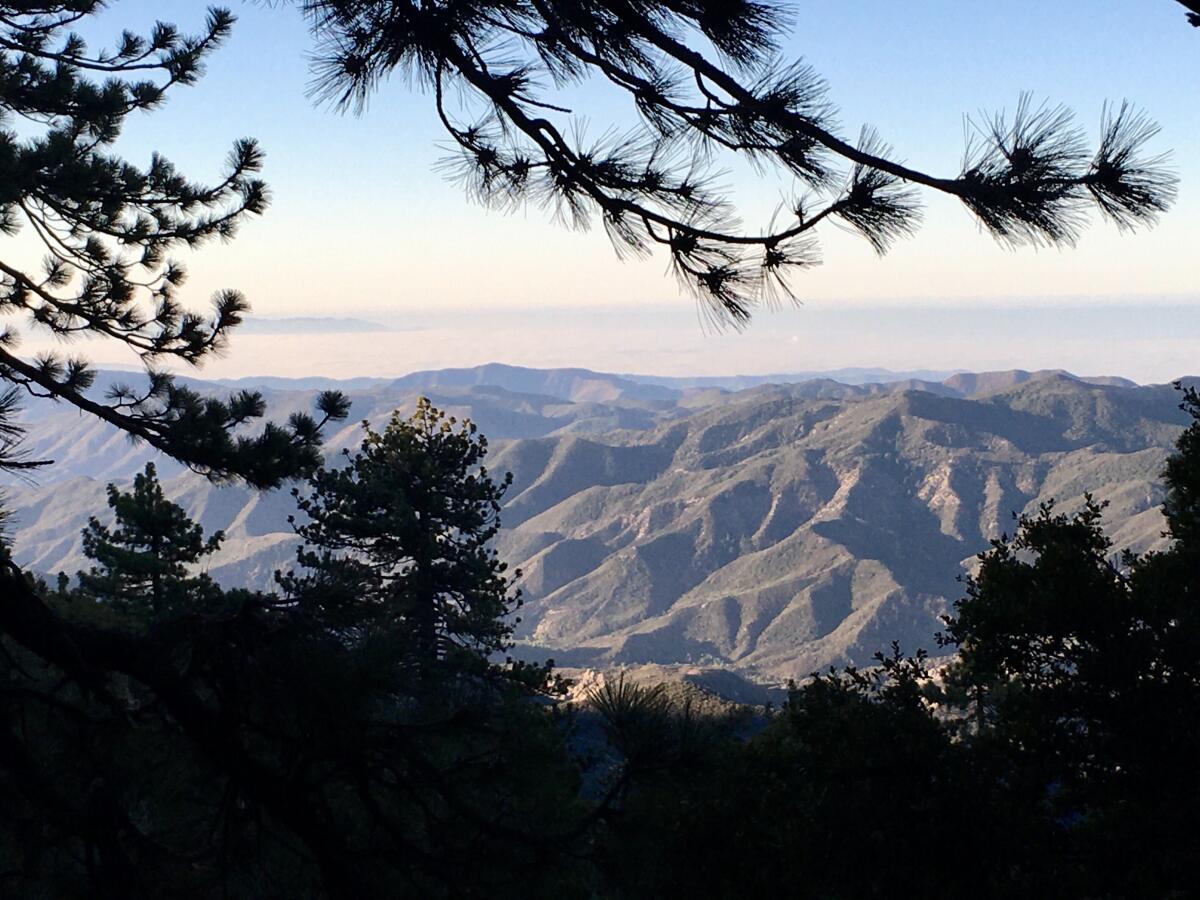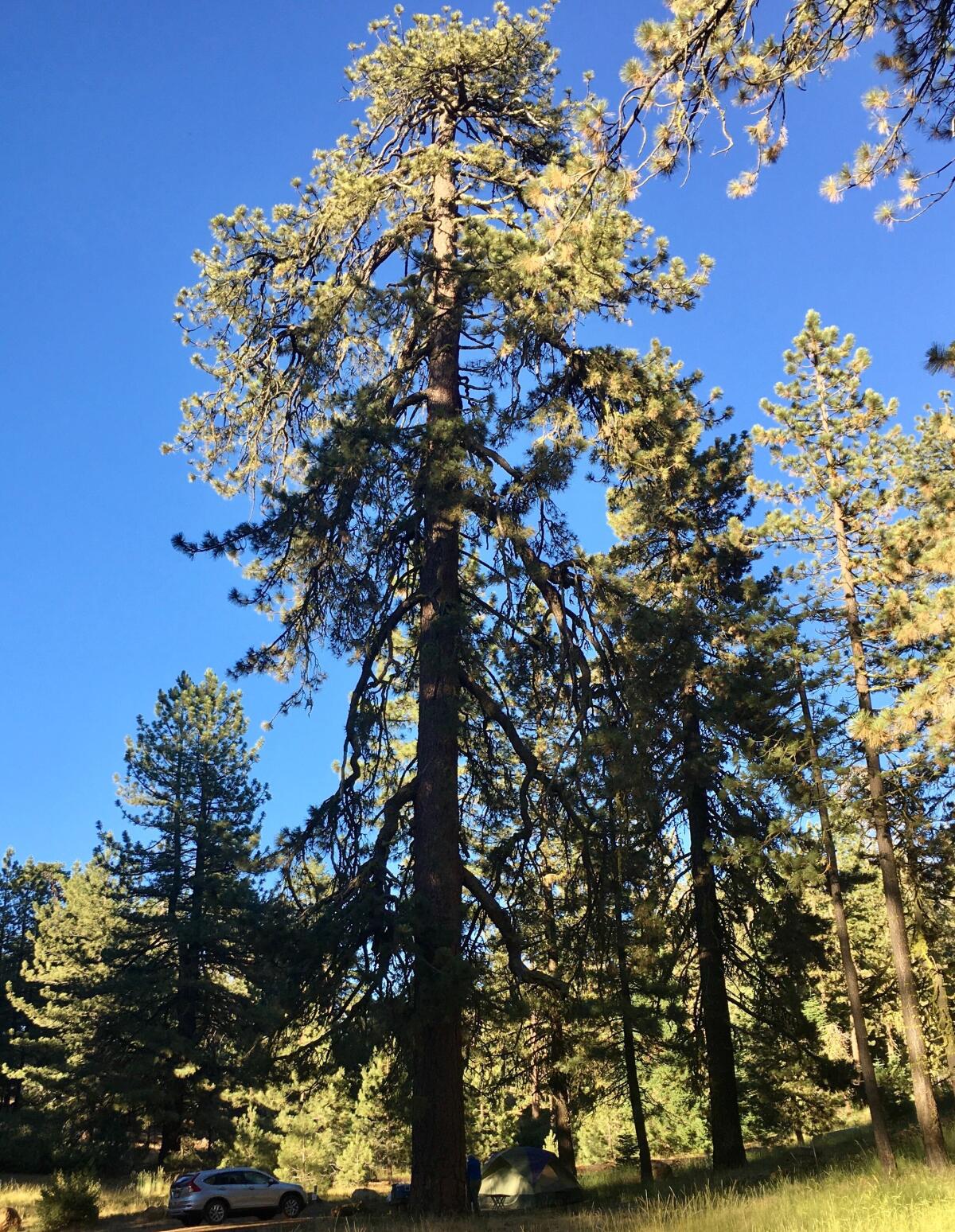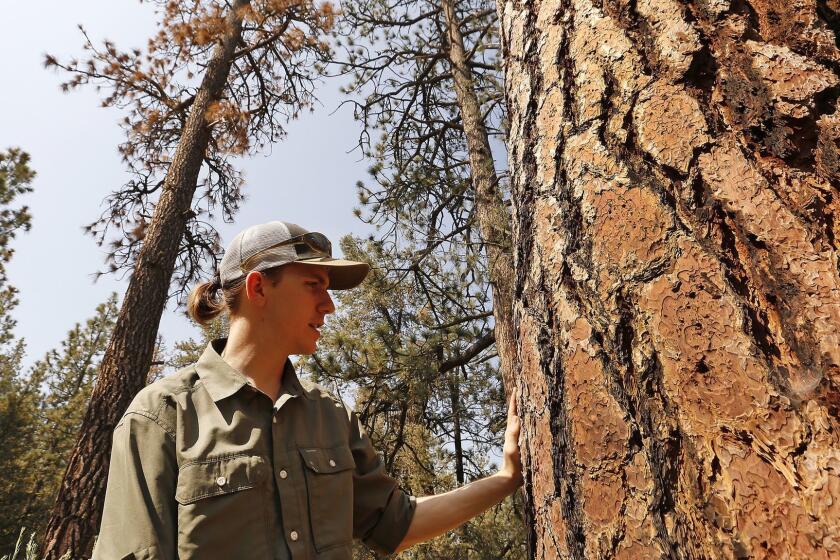Amid Pine Mountain’s ancient trees, a forest ‘thinning’ project triggers protests

- Share via
It rises 7,000 feet from the rugged foothills north of Ojai, in Ventura County. Known as Pine Mountain, it is home to rare California chaparral, hundreds of species of native plants and wildlife, and an old-growth pine forest the U.S. Forest Service wants to thin out with chain saws.
In the name of forest health and reducing wildfire risk, the Forest Service is proposing to thin 755 acres from Pine Mountain up to the adjacent Reyes Peak, mostly within Los Padres National Forest.
Yet conservation groups, city officials, outdoor enthusiasts and Chumash Nation leaders are questioning why the project is needed and the motivations behind it. Some plan to fight it.
“The Forest Service hasn’t provided us with the documents that we would need to really understand what and why they’re doing this,” said Rebecca August, advocacy director at Los Padres ForestWatch, one of the groups opposed to the project. “There are so few of these places left in California, and it’s really important to protect it and keep it in that state.”
Pine Mountain is at least 15 miles from the nearest community and 38 miles from Ojai, more than an hour’s drive on the curvy blacktop of Highway 33. Its remoteness attracts campers and also helps provide refuge for threatened red-legged frogs and critically endangered California condors. But with so few people and homes near Pine Mountain, August and others question why the Forest Service chose it as a site to reduce wildfire risks.
“Projects adjacent to communities are where you’re going to get the most impact,” she said, “but doing things way out in the middle of nowhere is hard to defend.”
The project’s timing — during a pandemic, and in what could be the final months of the Trump administration — also concerns environmentalists, who note the administration is pressing hard to fast-track logging projects on public lands nationwide.
In the case of Pine Mountain, the Forest Service wants to bypass standard requirements for community engagement and environmental assessments. To do so, it will make use of loopholes within the National Environmental Policy Act called “categorical exclusions,” which allow the agency to streamline projects it deems to be of limited environmental impact.
The exclusion directive, which is explicitly intended to “reduce paperwork and save time and resources,” was outlined in an executive order issued by President Trump in 2018. The Forest Service, which operates under the U.S. Department of Agriculture, issued a formal proposal to adopt the loosened standards in 2019.
Logging has long been among California’s most divisive environmental issues — and the controversy shows little chance of cooling as the Trump administration pushes new efforts to thin forests.
Yet the Forest Service maintains the project is not a “logging proposal,” as it has been characterized by opposition groups, and says it is necessary for the health of the forest and its surrounding communities.
“That location was designated because of insect and disease treatment,” said Forest Service project manager Katherine Worn. “And it’s on a ridge top, and that’s where you would put a fuel break.”
Pointing to a map of the area, Worn said the project is situated between the sites of the 2006 Day fire, which burned 162,702 acres, and the 2007 Zaca fire, which burned 240,000 acres.
“You want to reduce the density so fire doesn’t jump from tree to tree,” she said. “That’s why it’s located there: It’s a strategic area to fight fire from.”
Yet all of the maps, documents and data provided by the Forest Service have not been enough to quell community outrage. To date, more than 12,000 messages opposing the project have been submitted through the Los Padres ForestWatch commentary portal — at least four times more than any other project has received.
“Pine Mountain is one of the most beautiful mountains I have ever set foot on in this state, or any other state in the western states of our Country,” wrote one commenter, Gilbert Sauceda Jr. “I plead with you to reconsider your proposal to ‘thin it out.’”
In a letter to the Forest Service, Ojai Mayor John F. Johnston echoed Sauceda’s sentiments, calling Pine Mountain “a special place for many Ojai residents” and asking the Forest Service to consider alternate options.

But public outcry may not be enough to protect the treasured landscape. The Forest Service’s “timber targets,” or quotas for the production of wood, have increased steadily over the last few years: In 2017, the target for Los Padres National Forest was 200,000 cubic feet. In 2018, that number doubled to 400,000 cubic feet.
The 2020 target: 800,000 cubic feet of wood.
“All of these projects are driven by finances, or goals that are based on finances,” said Rick Halsey, director of the California Chaparral Institute, which opposes the plan. “The Trump administration has made it clear they want logs, they want clearance, they want local contractors to make money, and they really could care less about the natural environment.”
Although Worn acknowledged that the Forest Service will probably sell the wood — it’s better to use the material than waste it, she said — she maintained that fire reduction, not finances, is the motive for the project.
“The [timber] target tomorrow, next year, could be very different than this year,” she said, noting that targets tend to increase and decrease in regular cycles. “I don’t even pay attention to those because this isn’t a timber project. This is a blip. This is the tiniest little amount of wood product. It’s pretty much irrelevant.”
But for those who love the land, what could happen to the 755 acres is anything but irrelevant. Maura Sullivan, a representative for the Coastal Band of the Chumash Nation, said Pine Mountain holds significant historic and cultural value for the tribe’s members, who consider it part of their homeland.
“We’re fighting for our sacred sites in the face of what is continued colonization and imperialism,” she said, noting that clearing the landscape at Pine Mountain would be “an extreme blow to our spiritual and mental health as Chumash people.”
Sullivan also said Pine Mountain is home to several plants used by the tribe for basket-making, regalia and medicinal purposes, including some that support respiratory health during COVID-19. She also expressed concern that the Forest Service’s mechanical equipment could easily destroy grinding stones and other artifacts on the ground, which are easily hidden by the area’s carpet of pine needles.
On a recent Saturday afternoon, the park was alive with hikers, campers and families taking in the stately trees and pine-fresh air — one of the last remaining refuges for city dwellers otherwise stuck at home.
A printed news release on the back of an information board was the only indication of the proposed clearing project, or of the fact that the forest and chaparral may look very different the next time those families visit.
“It’s very suspicious,” said August, the ForestWatch director. “If I was to try to get something in as quietly as possible, I might introduce it during a pandemic when there’s social unrest happening, when people are very otherwise occupied.”
Along with other opponents, August also fears the project could harm the soil and the landscape long after the clearing is done. Much of the area has never been mechanically disturbed, and heavy machinery, including wood chippers and masticators, can mark the land for years to come.
“The biodiversity and richness will be dramatically reduced,” Halsey said.
Intensifying the debate are disputes about whether the proposed methods help or harm forest health. A 2016 review of U.S. research found that forest thinning and prescribed burning can reduce fire severity, but other studies found that the creation of fuel breaks can introduce invasive species and that forest thinning can increase carbon emissions and contribute to global warming.
Fuel breaks are also ineffective in stopping California’s most deadly fires, those driven by high winds, as The Times detailed in an investigation last year.
Our oceans. Our public lands. Our future.
Get Boiling Point, our new newsletter exploring climate change and the environment, and become part of the conversation — and the solution.
You may occasionally receive promotional content from the Los Angeles Times.
Chris Field, director of Stanford University’s Woods Institute for the Environment, said removing small ladder fuels — dead vegetation, shrubs and branches — from the forest floor can be an important tool for forest health and help prevent a fire from gaining intensity.
But, he said, if the project’s intention is to remove big trees, that’s “not helping at all.” Currently, the proposal calls for the thinning of 423 acres of conifer forest, with a primary focus on trees under 2 feet in diameter, and the clearance of 316 acres of chaparral.
Field also said that given the lack of consensus, and the variety of treatment options and locations available, these types of projects should be considered on an individual basis and account for site-specific concerns. Pine Mountain is currently included in the Forest Services’ list of special places.
“If something has iconic wilderness or recreation value, you wouldn’t necessarily want to go in with industrial equipment and chop everything up,” Field said. “You wouldn’t bring industrial-scale harvesting equipment around the governor’s mansion if you thought there needed to be some tree work there, too.”
Conservation groups are now gearing up for a fight. The public comment period for the proposal is slated to end Aug. 14, at which point Los Padres ForestWatch and the Chaparral Institute are prepared to file an injunction to stop the project from moving forward.
“The government is supposed to represent us, and it’s our job to watch the government,” Halsey said, noting that lawsuits are often the only way for environmental and conservation groups to have their concerns taken seriously.
“It’s not their forest,” he said. “It’s ours.”








